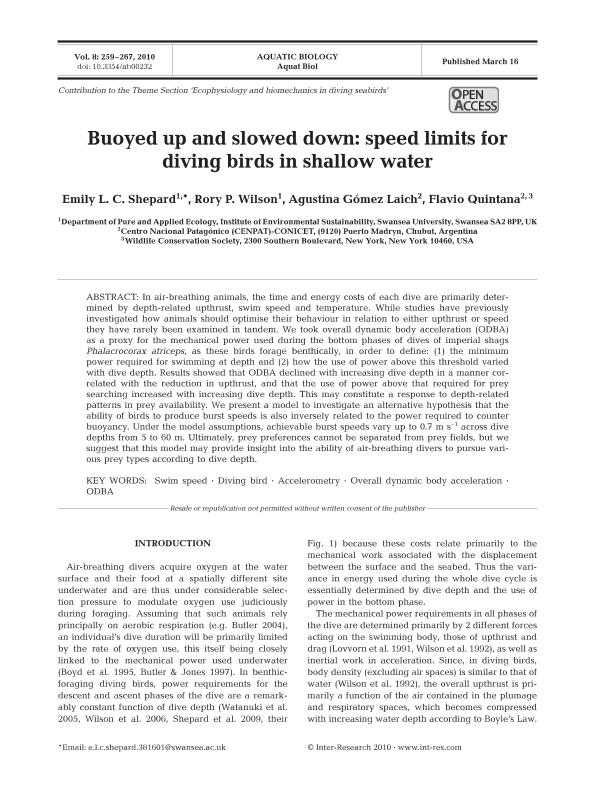Artículo
Buoyed up and slowed down: Speed limits for diving birds in shallow water
Fecha de publicación:
03/2010
Editorial:
Inter-Research
Revista:
Aquatic Biology
ISSN:
1864-7782
e-ISSN:
1864-7790
Idioma:
Inglés
Tipo de recurso:
Artículo publicado
Clasificación temática:
Resumen
In air-breathing animals, the time and energy costs of each dive are primarily determined by depth-related upthrust, swim speed and temperature. While studies have previously investigated how animals should optimise their behaviour in relation to either upthrust or speed they have rarely been examined in tandem. We took overall dynamic body acceleration (ODBA) as a proxy for the mechanical power used during the bottom phases of dives of imperial shags Phalacrocorax atriceps, as these birds forage benthically, in order to define: (1) the minimum power required for swimming at depth and (2) how the use of power above this threshold varied with dive depth. Results showed that ODBA declined with increasing dive depth in a manner correlated with the reduction in upthrust, and that the use of power above that required for prey searching increased with increasing dive depth. This may constitute a response to depth-related patterns in prey availability. We present a model to investigate an alternative hypothesis that the ability of birds to produce burst speeds is also inversely related to the power required to counter buoyancy. Under the model assumptions, achievable burst speeds vary up to 0.7 m s–1 across dive depths from 5 to 60 m. Ultimately, prey preferences cannot be separated from prey fields, but we suggest that this model may provide insight into the ability of air-breathing divers to pursue various prey types according to dive depth.
Palabras clave:
Accelerometry
,
Diving Bird
,
Odba
,
Overall Dynamic Body Acceleration
,
Swim Speed
Archivos asociados
Licencia
Identificadores
Colecciones
Articulos(CCT-CENPAT)
Articulos de CTRO.CIENTIFICO TECNOL.CONICET - CENPAT
Articulos de CTRO.CIENTIFICO TECNOL.CONICET - CENPAT
Citación
Shepard, Emily L. C.; Wilson, Rory P.; Gómez Laich, Agustina Marta; Quintana, Flavio Roberto; Buoyed up and slowed down: Speed limits for diving birds in shallow water; Inter-Research; Aquatic Biology; 8; 3; 3-2010; 259-267
Compartir
Altmétricas




